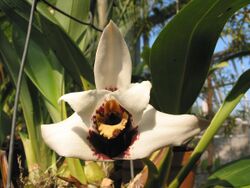Biology:Maxillariinae
From HandWiki
Short description: Subtribe of orchids
| Maxillariinae | |
|---|---|

| |
| Maxillaria sanderiana | |
| Scientific classification | |
| Kingdom: | Plantae |
| Clade: | Tracheophytes |
| Clade: | Angiosperms |
| Clade: | Monocots |
| Order: | Asparagales |
| Family: | Orchidaceae |
| Subfamily: | Epidendroideae |
| Tribe: | Cymbidieae |
| Subtribe: | Maxillariinae Benth. |
| Genera | |
|
See text. | |
Maxillariinae is an orchid subtribe in the tribe Cymbidieae.[1][2] It was formerly treated as the tribe Maxillarieae, and divided into a number of subtribes.[3]
Genera
Generic boundaries in the tribe have changed substantially with new molecular evidence. Whitten et al. in 2007 included the following genera, some previously placed in the tribe Lycastinae, others in the subtribe Bifrenariinae.[2] Some of these genera have subsequently been merged.
- Anguloa Ruiz & Pav.
- Anthosiphon Schltr. – since included in Maxillaria[4]
- Bifrenaria Lindl. (including Adipe Raf., Cydoniorchis Senghas, and Stenocoryne Lindl.)
- Brasiliorchis R.Singer, S.Koehler & Carnevali
- Chrysocycnis Linden & Rchb.f. – since included in Maxillaria[5]
- Cryptocentrum Benth.
- Cyrtidiorchis Rauschert
- Guanchezia G.A.Romero & Carnevali
- Horvatia Garay
- Hylaeorchis Carnevali & G.A. Romero
- Ida A.Ryan & Oakeley – since included in Sudamerlycaste[6]
- Lycaste Lindl.
- Maxillaria Ruiz & Pavón
- Mormolyca Fenzl
- Neomoorea Rolfe
- Pityphyllum Schltr.
- Rudolfiella Hoehne
- Scuticaria Lindl.
- Sudamerlycaste Archila
- Teuscheria Garay
- Trigonidium Lindl.
- Xylobium Lindl.
See also
References
- ↑ Chase, M.W.; Freudenstein, J.V.; Cameron, K.M. (2003), "DNA data and Orchidaceae systematics: a new phylogenetic classification", in Dixon, K.W.; Kell, S.P.; Barrett, R.L. et al., Orchid conservation, Kota Kinabalu, Sabah, Malaysia: Natural History Publications, pp. 69–89
- ↑ 2.0 2.1 Whitten, W.M.; Blanco, M.A.; Williams, N.H.; Koehler, S.; Carnevali, G.; Singer, R.B.; Endara, L.; Neubig, K.M. (2007). "Molecular phylogenetics of Maxillaria and related genera (Orchidaceae: Cymbidieae) based on combined molecular data sets". American Journal of Botany 94: 1860–1889. doi:10.3732/ajb.94.11.1860.
- ↑ Whitten, W. Mark; Williams, Norris H.; Chase, Mark W. (2000). "Subtribal and generic relationships of Maxillarieae (Orchidaceae) with emphasis on Stanhopeinae: combined molecular evidence". American Journal of Botany 87 (12): 1842–1856. doi:10.2307/2656837. PMID 11118422.
- ↑ "Anthosiphon Schltr.". Plants of the World Online. Royal Botanic Gardens, Kew. https://powo.science.kew.org/taxon/urn:lsid:ipni.org:names:30122901-2.
- ↑ "Chrysocycnis Linden & Rchb.f.". Plants of the World Online. Royal Botanic Gardens, Kew. https://powo.science.kew.org/taxon/urn:lsid:ipni.org:names:30101986-2.
- ↑ "Ida A.Ryan & Oakeley". Plants of the World Online. Royal Botanic Gardens, Kew. https://powo.science.kew.org/taxon/urn:lsid:ipni.org:names:325454-2.
Bibliography
- Whitten, W. Mark; Williams, Norris H.; Dressler, Robert L.; Gerlach, Günter; Pupulin, Franco (2005). "Generic relationships of Zygopetalinae (Orchidaceae, Cymbidieae): Combined molecular evidence". Lankesteriana International Journal on Orchidology 5 (2): 87–107. https://www.redalyc.org/pdf/443/44339808001.pdf. Retrieved 2020-09-09.
External links
Wikidata ☰ Q9030757 entry
 |

